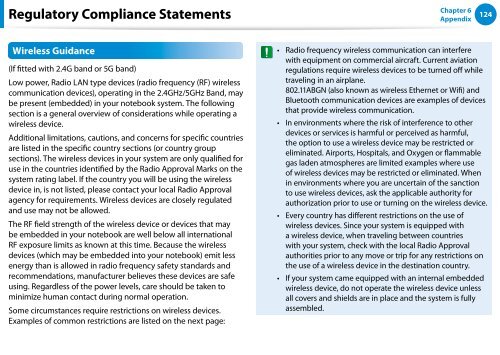Samsung Series 7 13.3” Notebook - NP740U3E-A01UB - User Manual (Windows 8) (ENGLISH)
Samsung Series 7 13.3” Notebook - NP740U3E-A01UB - User Manual (Windows 8) (ENGLISH)
Samsung Series 7 13.3” Notebook - NP740U3E-A01UB - User Manual (Windows 8) (ENGLISH)
Create successful ePaper yourself
Turn your PDF publications into a flip-book with our unique Google optimized e-Paper software.
Regulatory Compliance Statements<br />
Chapter 6<br />
Appendix<br />
124<br />
Wireless Guidance<br />
(If fitted with 2.4G band or 5G band)<br />
Low power, Radio LAN type devices (radio frequency (RF) wireless<br />
communication devices), operating in the 2.4GHz/5GHz Band, may<br />
be present (embedded) in your notebook system. The following<br />
section is a general overview of considerations while operating a<br />
wireless device.<br />
Additional limitations, cautions, and concerns for specific countries<br />
are listed in the specific country sections (or country group<br />
sections). The wireless devices in your system are only qualified for<br />
use in the countries identified by the Radio Approval Marks on the<br />
system rating label. If the country you will be using the wireless<br />
device in, is not listed, please contact your local Radio Approval<br />
agency for requirements. Wireless devices are closely regulated<br />
and use may not be allowed.<br />
The RF field strength of the wireless device or devices that may<br />
be embedded in your notebook are well below all international<br />
RF exposure limits as known at this time. Because the wireless<br />
devices (which may be embedded into your notebook) emit less<br />
energy than is allowed in radio frequency safety standards and<br />
recommendations, manufacturer believes these devices are safe<br />
using. Regardless of the power levels, care should be taken to<br />
minimize human contact during normal operation.<br />
Some circumstances require restrictions on wireless devices.<br />
Examples of common restrictions are listed on the next page:<br />
• Radio frequency wireless communication can interfere<br />
with equipment on commercial aircraft. Current aviation<br />
regulations require wireless devices to be turned off while<br />
traveling in an airplane.<br />
802.11ABGN (also known as wireless Ethernet or Wifi) and<br />
Bluetooth communication devices are examples of devices<br />
that provide wireless communication.<br />
• In environments where the risk of interference to other<br />
devices or services is harmful or perceived as harmful,<br />
the option to use a wireless device may be restricted or<br />
eliminated. Airports, Hospitals, and Oxygen or flammable<br />
gas laden atmospheres are limited examples where use<br />
of wireless devices may be restricted or eliminated. When<br />
in environments where you are uncertain of the sanction<br />
to use wireless devices, ask the applicable authority for<br />
authorization prior to use or turning on the wireless device.<br />
• Every country has different restrictions on the use of<br />
wireless devices. Since your system is equipped with<br />
a wireless device, when traveling between countries<br />
with your system, check with the local Radio Approval<br />
authorities prior to any move or trip for any restrictions on<br />
the use of a wireless device in the destination country.<br />
• If your system came equipped with an internal embedded<br />
wireless device, do not operate the wireless device unless<br />
all covers and shields are in place and the system is fully<br />
assembled.
















